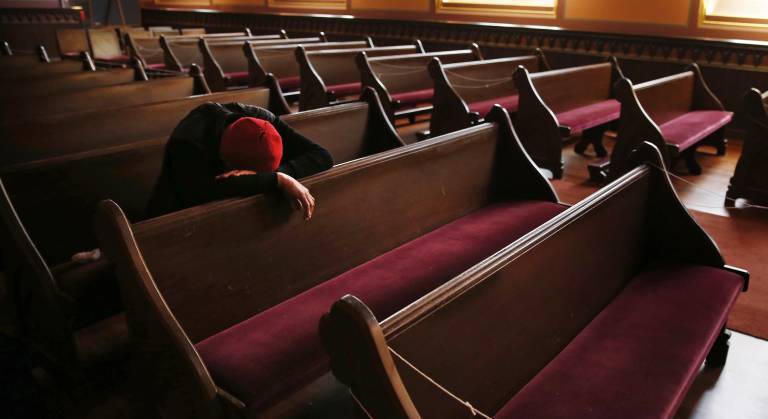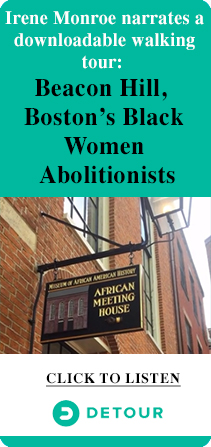
By Irene Monroe, published in WGBH News on May 27, 2020.
Places of worship have now been allowed to conduct in-person religious services in Massachusetts for over a week, under the first phase of the Baker administration’s four-phase reopening plan during the coronavirus pandemic.
But does the reopening really mark the return of public health and safety in congregating in houses of worship? Or is it more a result of pressure to grant legal permission to reopen in the name of freedom of religion? For as long as the state remains far from hitting its testing target but places of worship may reopen, the question is worth giving a hard look.
The guidelines around restrictions on places of worship has been like stepping on a landmine for Gov. Charlie Baker. Since the beginning of the state’s stay-at-home advisory in March, most churches have complied with the advice to close their physical doors for the time being.
But not all. In early May, about 260 minsters from across the commonwealth expressed their grievances in a signed letter to Baker, demanding their places of worship be allowed to reopen with social distancing protocols. Baker didn’t lift the advisory until last Monday.
“I want to open churches in a responsible and safe way to do that,” Baker said about the change in guidelines on WGBH News’ Boston Public Radio on Thursday. “… I had pressure around constitutional issues and couldn’t ignore it.”
Many faith communities, like the black church, have adjusted to social distancing. These communities have provided worshippers with spiritual and emotional care and pastoral counseling with video streaming or drive-in options. Faith traditions that use prayer books, hymnals, and religious texts as a worshiping body are not lost nor desecrated if now done virtually. And with black communities among the hardest hit by COVID-19, many of these churches have congregants with preexisting conditions whose jobs put them on the frontline battling the virus. Social distancing is a no-brainer.
However, the question of what limits local and state officials can place on religious practices in the name of public safety is an important one.
First, any limitations should be measured by the gravity of the crisis. Second, these limitations should be examined to see if places of worship are being singled out and discriminated against for stricter treatment. Neither were true for Baker’s advisory, from my perspective, despite the 260 ministers whose letter demanded their places of worship reopen by contesting infringement of freedom of religion and freedom of assembly.
With these First Amendment freedoms, in my opinion, comes responsibility.
The request for churches to suspend their usual in-person gatherings is not curtailing worship because other ways to worship can be employed, like virtual streaming. The guidance is a mitigation strategy to temporarily press a pause button on one form of religious expression: crowd size, a factor that can be directly tied to COVID-19 transmission.
If you want to add confusion to this delicate balance between church and state, First Amendment rights and the right to protect public health, simply add President Donald Trump to the mix. Trump made it emphatically clear on Friday that if governors did not follow his recommendations allowing in-person religious services to resume, he would “override” them.
“Some governors have deemed liquor stores and abortion clinics as essential, but have left out churches and other houses of worship. It’s not right,” Trump said at the White House. “I call upon governors to allow our churches and places of worship to open right now. … If they don’t do it, I will override the governors.”
Now, to side-step the stir Trump started, the new guidelines from the Centers for Disease Control and Prevention state that “[t]he information offered is non-binding public health guidance for consideration only; it is not meant to regulate or prescribe standards for interactions of faith communities in houses of worship.”
The CDC suggested restrictions on places of worship were supposed to help prevent a virus resurgence. The resulting change — stemmed from Trump exploiting the issue for his reelection campaign — has just brought confusion to those of us who are religious leaders, and are looking toward experts to guide our decisions.
During an Interfaith Community Leadership Zoom call for Cambridge clergy last week, during which we discussed the governor’s Mandatory Safety Standards and Checklist for Houses of Worship, confusion — not clarity — abounded as we compared the CDC’s earlier guidelines, advising gatherings of no more than 10 people, to the governor’s new instructions, which limit the occupancy inside places of worship to 40 percent. It’s difficult to discern what is safe.
Baker was no doubt under pressure not to be too prescriptive in lifting the advisory for places of worship. But during this pandemic, the ongoing challenge for places of worship will continue to be how to reopen and to protect public health.
In an already divided country, health precautions should not be weaponized as an infringement on religious liberty. Instead, they should be seen as “essential” for maintaining the well-being and sustainability of a worshiping body.
In Massachusetts, the number of coronavirus-related deaths is on the decline. Keeping hotspots like places of worship safe for our communities can continue to help in its decline.
Published in WGBH News on May 27, 2020.



